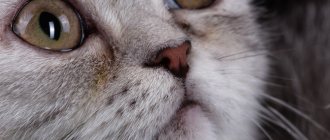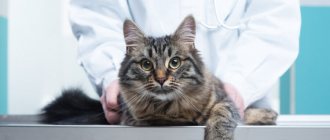Mustachioed pets are a joy for every home. But all cat owners sooner or later face the issue of sterilization. This is a medical procedure that is absolutely safe for animals and is successfully performed by veterinarians all over the world. Our Murkosha shelter also sterilizes all animals, since we are against reproduction. Today there are so many homeless kittens on the streets. Cats give birth to dozens of babies, and for owners, housing such a huge number of kittens becomes simply an impossible task.
That's why we sterilize all animals ourselves before sending them to the Murhappy Project for adoption, and we recommend that anyone who wants to get a kitten do the same.
Types of sterilization
There are medical, radiation and surgical sterilization of cats, each has its pros and cons. A more favorable option is surgical. With medical sterilization using hormonal drugs, there is a high risk of the appearance of neoplasms, including malignant ones.
Many doctors consider the method using radiation to be detrimental to the animal, because with the slightest error in calculating the dosage of radiation, it can negatively affect the condition of the cells.
The most commonly used surgical method of sterilization is ovariohysterectomy—the complete removal of the uterus and ovaries. There are other options - tubal occlusion (tightening of the fallopian tubes), hysterectomy (removal of only the uterus), oophorectomy (removal of only the ovaries).
The last of these methods is the most preferable, but is used only for young nulliparous animals. The other two have a very adverse effect on the health of cats, so they are almost never used in modern veterinary medicine.
Three ways to perform the operation
Simple cavitary
This is when an incision is made along the abdomen. All abdominal organs are visible. This makes it convenient for the doctor to work. But the animal will have a large seam. Medical threads can only be removed after 10-12 days. During this time, the animal will wear a protective blanket or collar.
Side cut
The surgeon performs manipulations through a small hole directly above the organ to be removed. This method is suitable for young females with normal weight who do not yet have any pathology of the reproductive system. But in obese cats, it is better to remove the ovaries and uterus using the first method.
Endoscopic method
The veterinarian performs a couple of punctures in the abdominal cavity. Then, with the help of manipulators, the reproductive organs are removed. The modern method provides maximum sterility of the operation. Because there is no direct contact of air and the surgeon’s hands with the internal organs. Wounds measuring 5 mm heal quickly. Fluffy patients forget about the unpleasant procedure the very next day.
Pros of sterilization
According to the observations of our specialists, sterilized cats live longer and healthier lives. Cats become calmer, maintaining both their appearance and behavior; in addition, they will no longer bear unwanted offspring.
After sterilization, the risk of cancer, polycystic disease, pyometra and other diseases that affect almost every nulliparous cat over 5 years of age is significantly reduced. As a result of improved metabolism, the animal requires less feed, which leads to savings in food costs. Animal owners consider it right that they decided to undergo the operation, since after it the cat does not have exhausting heats, no unnecessary kittens, she is always active, playful, with shiny, luxurious fur, which she did not have before.
How is sterilization different from castration?
The standard procedure for removing the uterus is carried out in all veterinary clinics. Proper preparation reduces all risks to a minimum. It is recommended to begin preparations at least two weeks before the intended sterilization.
To properly prepare your pet for medical intervention, you must:
- take blood tests;
- take a general urine test;
- undergo an examination by a cardiologist and do an ECG (especially if the animal is 7-8 years old);
- do an ultrasound (according to indications).
If any abnormalities are detected, the operation will be delayed.
Attention! Before carrying out the manipulation, it is necessary to carry out unscheduled treatment against worms and vaccination against rabies. Data about these procedures are entered into the animal’s veterinary passport. Without this information, the cat may not be allowed on the operating table.
Technique
You can castrate a female in the first two days after the start of estrus. An incision is made in the animal's abdominal cavity, the uterus is excised and removed, and then stitches are applied. After this manipulation, the cat will need to wear a blanket for a long time to prevent infection of the stitches.
After sterilization, the owner’s main task is to provide the cat with peace and not let it go outside. Also, the animal should be protected from sudden changes in temperature and fed moderately, because heavy food can cause vomiting.
After surgery, your pet may feel chills or nausea
Attention! After surgery, the animal may behave aggressively or, conversely, lethargically. This is how the delayed effect of anesthesia manifests itself. There is no need to worry - this phenomenon passes quickly.
We suggest you read: If you are bitten by a rabid cat: symptoms and signs of rabies in a person after being bitten by a cat or cat, is there a rabies vaccine for people
Removing a cat's uterus surgically has many benefits, such as:
- protection from unwanted offspring;
- increasing the life expectancy of the animal;
- improving the cat's character;
- normalization of hormonal levels.
But most importantly, the cat will begin to behave calmer and will not ask to go for a walk. This is especially important for owners who keep pets in large cities, where pets cannot be left unattended for a long time.
In order for the animal to safely undergo castration, the cat must be properly prepared for medical intervention. This will help avoid serious postoperative complications and psychological stress. If everything went well, the cat needs a good gentle regimen for at least a month. Then she will quickly regain her physical strength and finally recover.
During surgical sterilization, obstruction of the tubes leading from the ovaries to the uterus is created. The sperm will not meet the egg and fertilization will not occur. Of course, in this case there will be no more kittens and there is no need to worry about accidental matings. But sexual attraction remains.
If there is no fertilization in the cat, estrus will begin again after 2 weeks or an imaginary pregnancy will develop, which can easily be confused with the real one. An attempt to deceive nature most often ends in hormonal imbalances, giving rise to a tumor process.
Castration is the removal of the ovaries and appendages. It is this solution that allows you to save the cat and those around you from the torment that accompanies estrus. If the operation is carried out carelessly and a piece of reproductive tissue remains, there will be no discharge from the loop, but the animal will not get rid of periodic meowing.
Therefore, the term “sterilized” should mean a castrated cat. Often the uterus is also removed along with the ovaries. Deprivation of genital organs alters the female's metabolism and behavior. Therefore, you will have to forget about natural food and cheap economy class food.
For sterilized cats, special foods are produced that prevent obesity and related diseases.
Be sure to read:
Is it worth castrating a cat: optimal age, is it harmful, what will happen if the operation is not performed
Abdominal surgery is performed under general anesthesia. Since pets are prone to vomiting, the cat is not fed for more than half a day before surgery.
Be sure to read:
We suggest you read: How to find out the gender of a red-eared slider
Castration of a cat: how it happens: how it is done, methods, what is removed and at what age
There are several methods for removing reproductive organs, in which the ovaries with appendages or uterus are removed through an incision, a ligature is applied and bandaged. At the request of the cat owner, the veterinarian applies an intradermal suture, which is processed once on the operating table.
Cons of sterilization
There are also negative sides to sterilization. Since the hormonal background does change after surgery, other changes occur in the body, including negative ones. Changes in metabolism require a completely different diet. After sterilization, energy needs are noticeably reduced; along with an increase in appetite, this can lead to an increase in the animal’s weight. To prevent the risk of obesity, the cat is switched to special food. Of course, this is not a serious obstacle if the health of the pet is at stake and sterilization of the cat is required.
Postoperative period
The postoperative period takes place at home. The sterilization procedure involves cutting into the abdomen, so recovery can be lengthy and painful.
The pet wears a special bandage for 1-2 weeks after the procedure. Hyperactive individuals are given a collar that prevents the animal from scratching and licking the seams.
For 7 days after completion of sterilization, it is recommended to give the animal liquid food so as not to burden the digestive organs, as well as to drink plenty of clean water.
You should protect your pet from playing with children and other activities so that the seams do not come apart. The seams should be wiped once a day with a solution of Miramistin or Chlorhexidine.
The procedure of sterilization and castration can be difficult for a pet, so it is necessary to provide him with peace and comfort during rehabilitation.
At what age should sterilization be done?
In the absence of medical contraindications, it can be performed regardless of age. The most favorable period for sterilization is when the body is almost completely formed, but sexual maturity has not yet occurred, i.e. before the first heat.
We recommend performing such operations at the age of 8-10 months. At this time, animals tolerate such procedures much easier, and the recovery process goes faster. The risk of mammary tumors is also minimal, which increases with each subsequent estrus. Some veterinarians claim that the timing of a cat's sterilization does not matter at all for future development. And they operate on kittens as young as 2 months. But this opinion is not very supported by the majority of their colleagues, who believe that surgery at such an early age can lead to disturbances in the development of internal organs.
When can cats be spayed?
Veterinarians advise castrating an animal (regardless of gender) at 7-8 months. By this time, the body is almost completely formed, and the risks of negative consequences are minimized.
Castration of animals whose age exceeds 1-1.5 years is carried out only for medical reasons. These include:
- cryptorchidism (one or two undescended testicles);
- ovarian cysts;
- oncological diseases of the genital organs;
- mammary cancer;
- testicular injury;
- inflammatory diseases (in females: endometritis, pyometra; in males - orchitis, epididymitis);
- in the scope of treatment of breast cancer in females.
Only a veterinarian can determine the need for castration after examining the animal and conducting additional examination (ultrasound, laboratory diagnostics).
Preparing for surgery
To make it easier for your cat to tolerate anesthesia, you should not feed it before surgery. The last portion of food is given at least 12 hours before. Anti-flea treatment is required. To prevent the cat from damaging the seam in the future, its claws must be trimmed in advance with a special nail clipper. The animal is usually transported in a carrier bag; you can use a bag made of thick material or a backpack for this purpose. If the distance to the clinic is short, it is better to walk and try to prevent the cat from becoming stressed and panicky.
What should be done before the operation?
Sterilization or castration is considered a planned operation. You need to prepare for it in advance. I went to the local veterinary clinic and got a consultation.
The first thing the doctor asked me was my beauty’s age, weight, whether or not she had been vaccinated and treated for parasites.
My Kisa was already 7 months old at that time. She weighed 3 kilograms. She hasn't had her first heat yet. Antiviral vaccinations were given.
But I haven’t given kitsuna anti-worm medication for a long time. And it is necessary to drive away helminths before sterilization.
The doctor advised me to buy the anthelmintic drug Prazicide Plus. It turns out that after taking the drug for worms, the operation can be performed no earlier than 11-12 days later.
The surgeon signed up Kisa for scheduled sterilization in two weeks. He said that the cat should be hungry before the operation: the last feeding is 10-12 hours before the execution.
What to do after sterilizing a cat
The first days after surgery, the cat is in dire need of care. At home, you need to prepare the box in advance by putting warm bedding in it and placing it near a radiator or heater. The animal may experience severe chills while the anesthesia wears off. After sterilization, cats sleep almost all the time for the first 24 hours, so it is advisable to maintain peace and quiet in the house and monitor the animal’s breathing. The condition of the seams must be checked daily, treating with hydrogen peroxide and brilliant green. If they become red, swollen, or the animal’s health worsens, you should immediately consult a doctor.
As a rule, a cat does not eat after sterilization. On the first day, she is given water or milk from a syringe, and a day later she drinks on her own. Appetite appears gradually. After 3-4 days, the cat begins to behave more actively, but excessive mobility should be limited for now. After a week, the stitches are removed, and very soon the animal makes a full recovery.
Changes in physiology and behavior
The first heat or estrus begins in cats after the completion of puberty at 6–10 months, in large breeds later.
From this moment on, it repeats regularly, accompanied by hormonal surges and behavioral changes. The reproductive cycle consists of the following stages :
- The preparatory period , proestrus , lasts 2–3 days. Under the influence of the gonadotropic hormone of the pituitary gland, the growth of ovarian follicles begins, and the secretion of estrogen increases. The uterus swells, its walls thicken, and a liquid transparent secretion is released. The reproductive system prepares for mating and ovulation. The pet becomes excited, fawns over its owners, meows, scratches surrounding objects, but does not let the cat near.
- The second stage , estrus , lasts 6–7 days. The concentration of estrogen increases, the uterus prepares to accept and store the embryo. The female makes guttural sounds, inviting a partner, crouches to the floor, raises her tail, and walks on bent legs. She runs to the litter box more often, marks her territory, hardly eats, and drinks a lot. The vulva enlarges, clear mucus without blood is secreted, which the animal licks. During mating, the secretion of luteinizing hormone increases, which stimulates the rupture of follicles. After ovulation, the amount of estrogen decreases sharply. The ovaries form the corpus luteum, which secretes progesterone. Under its influence, the endometrium thickens, and the uterus awaits the embryo. Fertilization occurs 1–2 days after mating.
- The third stage , metestrus , lasts 8 days. After ovulation, the sexual instinct dies out, the female ceases to be interested in cats, and behavior returns to normal. If fertilization does not occur, the concentration of progesterone drops, and physiological changes are repeated in the reverse order. Sometimes an animal begins to have a false pregnancy. If the female does not meet a partner and mating does not occur, the cycle repeats after 3 weeks.
At the end, the resting phase begins - anestrus; this happens more often in the winter season, when daylight hours are reduced, lasting from 3 weeks to 3 months. Hormonal levels are stabilizing.
Possible complications after sterilization
If the operation is performed at the Moscow Veterinary Academy LDVTs MVA, then any inflammatory processes are practically excluded. If an animal that is aged or has chronic heart disease is subjected to sterilization, then it is first examined by a cardiologist.
Some animals have an acute reaction to anesthesia, which cannot be predicted in advance. This occurs more often in animals with allergies. Therefore, during such an operation as sterilization of cats, an individual selection of drugs is carried out.
Why choose our clinic?
If you decide to inexpensively sterilize a cat in Moscow, then there is no better place than the Dr. Vetson" You won't find it. We guarantee:
- high-quality diagnostics using modern equipment;
- individual approach to solving each problem;
- performing planned and emergency operations of any complexity;
- monitoring the animal’s condition in the postoperative period;
- access to a veterinary pharmacy with quality medicines;
- the use of inhalation anesthesia, which guarantees a high degree of controllability;
- monitoring the patient's condition during surgery;
- high-quality execution of internal sutures that do not require removal and dissolve on their own.
We treat cats of all breeds. Discounts are offered to regular customers. To find out the cost, call or write to us. The clinic administrator will make an appointment for you with a veterinary surgeon at a convenient time.
Nutrition for a sterilized cat
The diet is prepared immediately after the operation. It can consist of ready-made industrial food or homemade natural food. It is not advisable to mix these two types of food.
When feeding a cat natural food, preference is given to lean meat, offal, and milk porridges. Fermented milk products are recommended - cottage cheese and kefir. You cannot feed a sterilized cat fish, because it contains a lot of magnesium, the excess of which leads to the formation of salt stones. Commercial food manufacturers offer a variety of special products for sterilized cats. From all the variety, it is better to choose food from the premium segment. They are made from selected products, well-balanced, safe and widely recommended by specialists after such an operation as sterilization of cats. Reviews of food in this class are mostly positive.
The combination of a balanced diet and monitoring your pet’s health guarantees him a long and happy life!
Indications and contraindications
There may be the following indications for sterilization:
- No need for breeding. If you are not planning kittens, you should think about sterilization. Every heat is stress for the body. They can recur in cats at intervals from several days to several weeks. The body will restart this cycle until fertilization occurs. Often, instead of pregnancy, hormonal disorders occur, leading to serious consequences and even cancer.
- Tumors and cysts of the reproductive organs.
- Inflammatory processes in the uterus. This could be pyometra or endometritis (inflammation of the uterus with or without pus). Such diseases are difficult to treat, and there is often a risk of rupture of the uterine wall. Removing the affected organ is the only way to help your pet.
- Pathologies of pregnancy and childbirth. If the kittens die during gestation or the cat cannot give birth, she will need urgent surgery.
Contraindications to surgery may include:
- Diseases of the internal organs: inflammation of the liver, kidneys, periodic vomiting against the background of chronic enteropathy, etc. In such cases, it is worth first restoring the health of your pet and only then contacting a surgeon for scheduled sterilization.
- Diseases of the respiratory system: respiratory tract infections, chest injuries, diaphragmatic hernia, etc. During anesthesia, breathing slows down a little, and if the pet is unwell, then the risk of complications during anesthesia greatly increases.
- Diseases of the cardiovascular system: hypercardiomyopathy, defects, congestive heart failure increase anesthetic risk.
- Blood diseases: coagulation disorders, hematopoietic pathologies, red bone marrow diseases, oncology, etc. In this case, any surgical manipulation is dangerous.
- General malaise, underweight, etc. We are talking mainly about animals picked up on the street or taken from shelters. The cat may be stressed, eat poorly, hide, or be too thin. You need to let her get used to the house, to you, and monitor how she feels. If the weight is too low and bones are visible, then first you need to fatten up your new pet a little. Then recovery after surgery will be faster.
It is important to clarify that if the operation is necessary for medical reasons (pyometra, pathology of pregnancy), then the doctor may decide to sterilize, despite contraindications, since these diseases threaten the pet’s life.











